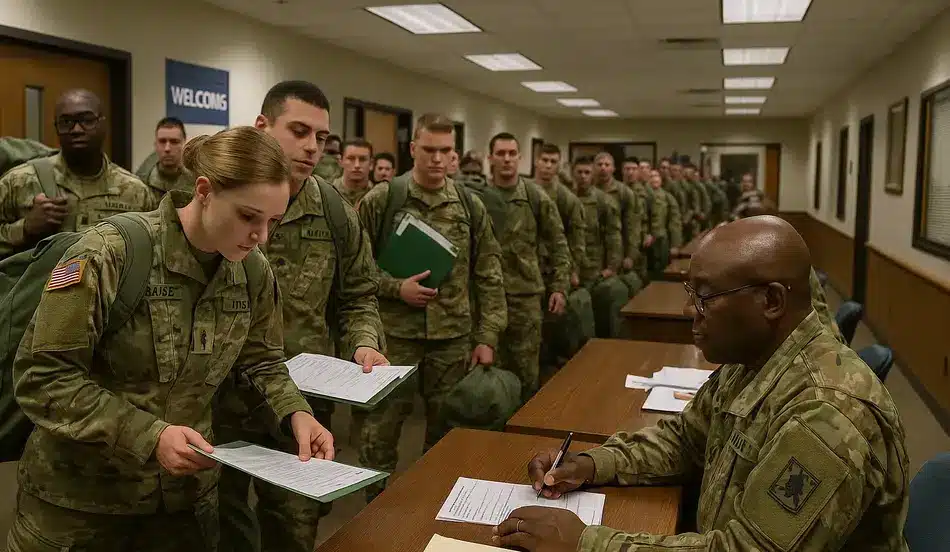The U.S. military is experiencing a paradoxical challenge. After years of falling enlistment numbers, branches are finally seeing an encouraging uptick in recruitment. But just as more Americans step forward to serve, the very system designed to screen, process, and usher them into boot camp is faltering.
At the heart of this growing crisis lies the Military Entrance Processing Command (MEPCOM), a little-known but absolutely vital organization that manages the intake pipeline for every recruit across the Army, Navy, Air Force, Marine Corps, Space Force, and Coast Guard. With staffing shortages crippling its ability to process applicants at scale, MEPCOM has become an unexpected chokepoint in the military’s efforts to rebuild its ranks.
The consequences could ripple well beyond missed recruitment goals, threatening the effectiveness of the all-volunteer force that underpins U.S. national security.
The Gatekeeper of Enlistment
For decades, MEPCOM has quietly functioned as the military’s front door. Its network of 65 Military Entrance Processing Stations (MEPS) spans the country, ensuring that every potential recruit undergoes rigorous evaluation.
A candidate’s journey through MEPS typically involves:
- Armed Services Vocational Aptitude Battery (ASVAB) testing, measuring intellectual readiness.
- Medical exams, ranging from vision and hearing to cardiovascular and psychological screenings.
- Background checks, verifying citizenship, criminal history, and security concerns.
- Contracting and oath ceremonies, officially swearing recruits into service.
In short, no recruit steps into basic training without passing through MEPCOM. The system is built to balance speed with scrutiny, ensuring readiness while maintaining strict quality standards.
Why the Pressure is Mounting Now
A Surge in Applicants
The past two years have seen a rare rebound in military recruitment. After missing end-strength goals in 2022 and 2023, aggressive outreach campaigns, signing bonuses, and revamped messaging helped boost enlistment interest by late 2024. By mid-2025, MEPCOM was handling more recruits than at any time in over a decade.
In 2022, the command processed roughly 215,000 medical exams. That number surged to 312,000 in 2024. Remarkably, officials say 2025 is already on track to surpass both totals—with more than 170,000 processed in just the first half of the year.
Staffing Shortfalls Collide with Rising Demand
Yet MEPCOM is dangerously understaffed. Nearly one-third of its facilities report significant labor shortages, and at least 20 stations have reduced their intake capacity—some by as much as 20%. That means fewer recruits can be processed each day, extending wait times and creating regional bottlenecks.
The Root Causes of the Crisis
Civilian Workforce Strain
Unlike active-duty military recruiters, most MEPCOM personnel are civilians—administrators, nurses, technicians, and IT staff. Their pay is often lower than private-sector equivalents, especially in high-cost-of-living cities. Turnover is high, and open positions linger unfilled for months.
Slow Federal Hiring Process
Although MEPCOM is technically exempt from federal hiring freezes, the bureaucracy surrounding federal HR approvals has slowed new hires dramatically. Some recruits for staff positions wait up to six months for clearance, far too long to fill urgent gaps.
Retirement Incentives Backfire
The Army’s voluntary retirement and buyout programs—designed to trim costs—have siphoned away thousands of experienced civilian employees. MEPCOM has struggled to replace them, leaving fewer trained staff to manage an accelerating workload.
Fill Critical Civilian Roles Faster
Post your job on WhatJobs and reach administrators, nurses, technicians, and IT professionals—helping you overcome turnover, delays, and talent shortages.
Post a Job Now →Consequences for the Armed Forces
Recruitment Gains at Risk
If recruits are delayed at MEPS, they cannot ship to basic training on time. That creates cascading problems: missed start dates for boot camp cycles, wasted recruiter hours, and frustrated enlistees who may simply walk away.
Readiness Concerns
Recruitment isn’t just about numbers—it’s about timing. The military counts on steady flows of trainees to fill operational units. If MEPCOM bottlenecks slow the intake pipeline, units could face shortages months or even years later.
Financial Waste
The Department of Defense spends billions annually on recruitment campaigns and enlistment bonuses. Delays in processing mean those investments yield no immediate returns. Outreach dollars are wasted if recruits get stuck in limbo.
Erosion of Public Trust
Perhaps most importantly, young Americans willing to serve may be turned off by bureaucratic inefficiency. In an era when military service already competes with civilian job markets offering higher pay and lower risk, first impressions matter.
Build Trust From the First Impression
Post your job on WhatJobs and connect with motivated young professionals—show them careers that offer stability, purpose, and respect from day one.
Post a Job Now →A System in Slow Motion
At some MEPS facilities, what used to be a two-day screening process now drags into weeks. Reports suggest that in large metropolitan areas like Los Angeles, Dallas, and Chicago, backlogs stretch into months, forcing recruits to wait for exam slots.
One MEPCOM insider described it bluntly: “We’re not broken yet, but we’re bent close to the breaking point.”
Searching for Solutions
Streamlined Hiring
Experts argue that MEPCOM should be granted direct hiring authority, enabling local commanders to bypass lengthy federal HR procedures.
Retention Bonuses
To keep experienced civilian staff from leaving, the Pentagon could implement targeted retention bonuses in high-cost or high-volume regions.
Temporary Surge Staffing
Deploying temporary contractors, cross-branch military medics, or National Guard personnel to high-volume MEPS could help ease backlogs in the short term.
Digital Modernization
Portions of the screening process, such as aptitude testing or initial paperwork, could be digitized and conducted remotely, reducing the load on physical facilities.
Historical Parallels
This isn’t the first time the military has faced a bottleneck at its intake centers.
- World War II: Local draft boards were overwhelmed by massive numbers, requiring federal intervention to standardize processing.
- Vietnam Era: Rapid scaling of intake clashed with social unrest, leading to quality-control issues.
- Post-9/11 Surge: Recruiting spiked, but MEPS had to be rapidly reinforced to keep up.
Today’s challenge differs: rather than too many recruits, the bottleneck is driven by too few staff—a reminder that even in the age of automation, human expertise remains indispensable.
Looking Ahead
If MEPCOM cannot fix its staffing shortages, 2026 could see a paradox: thousands of willing recruits, billions spent on recruitment, and yet a weakened force unable to onboard them efficiently.
Conversely, if reforms are fast-tracked—streamlined hiring, digital modernization, and short-term surge staffing—the crisis could transform into an opportunity, modernizing the system for decades to come.
The stakes are high. As one defense analyst put it: “You can’t fight tomorrow’s wars if today’s recruits never make it to basic training.”
FAQs
Q1: What exactly does MEPCOM do?
MEPCOM runs 65 Military Entrance Processing Stations across the U.S., conducting aptitude testing, medical exams, background checks, and formal enlistment ceremonies. No recruit enters basic training without going through MEPS.
Q2: Why is there a staffing crisis now?
High civilian turnover, slow federal hiring processes, and mass retirements have left many MEPS understaffed just as recruitment numbers are rising sharply.
Q3: How serious is the problem?
At least 20 MEPS have already cut capacity, some by 20%. Officials warn that without swift reforms, intake delays could cripple the military’s recruitment pipeline within months.
Q4: What solutions are being proposed?
Ideas include giving MEPCOM direct hiring authority, offering retention bonuses, deploying temporary surge staff, and digitizing parts of the screening process to reduce strain.
Conclusion
The U.S. military is standing at a crossroads. For the first time in years, Americans are showing renewed interest in enlisting. But unless MEPCOM can scale up to match that enthusiasm, the military risks missing its moment.
The all-volunteer force depends not just on recruiting numbers, but on a functional, efficient pipeline to transform civilians into soldiers, sailors, airmen, and Marines. Today, that pipeline is clogged. Tomorrow, it could be broken—unless decisive action is taken.
The staffing crisis at MEPCOM may not be as visible as troop deployments or battlefield technologies, but it could prove just as decisive in shaping America’s future military readiness.




